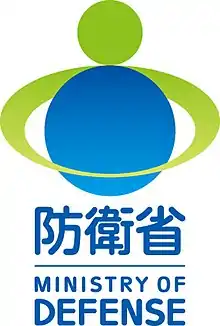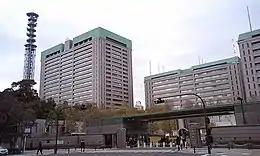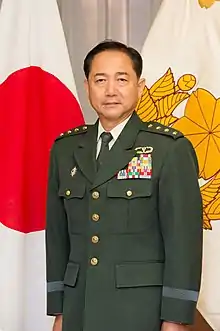Ministry of Defense (Japan)
The Ministry of Defense (防衛省, Bōei-shō) is a cabinet-level ministry of the Government of Japan charged with preserving the peace and independence of Japan and maintaining national security with the Japan Self-Defense Forces.[1]
| 防衛省 Bōei-shō | |
 | |
| Agency overview | |
|---|---|
| Formed | 9 January 2007 |
| Preceding agency |
|
| Jurisdiction | |
| Headquarters | 5-1 Ichigaya-honmuracho, Ichigaya, Shinjuku-ku, Tokyo, Japan |
| Employees | 22,721 civilian staff (2010) |
| Annual budget | 4.7 trillion yen |
| Ministers responsible |
|
| Parent agency | Government of Japan |
| Child agencies | |
| Website | https://www.mod.go.jp/e/ |
Headed by the Minister of Defense, it is the largest organ of the Japanese government. The ministry is headquartered in Ichigaya, Shinjuku, Tokyo, and is required by Article 66 of the Constitution to be completely subordinate to civilian authority.
History

On 8 June 2006, the Cabinet of Japan endorsed a bill elevating the Defense Agency (防衛庁, Bōei-chō) under the Cabinet Office to full-fledged cabinet-level Ministry of Defense (防衛省). A bill that relates to the transition of the DA from agency to a ministry became law on 15 December 2006 with approval from the House of Councillors.[2]
53 years after the establishment of the Defense Agency in 1954, the Ministry of Defense was founded on 9 January 2007.[3]
The Ministry of Defense is headquartered in Ichigaya, Shinjuku, Tokyo, on a site which housed the Imperial Japanese Army Academy (陸軍士官学校), built-in 1874, the GHQ of the Imperial Japanese Army before and during World War II, and of the Japan Ground Self-Defense Force following the war. The Japanese Defense Agency was established on 1 July 1954. Until May 2000, it was based in Akasaka (currently occupied by Tokyo Midtown).
The Ministry of Defense is required by Article 66 of the Constitution to be completely subordinate to civilian authority. Its head has the rank of Minister of State. He is assisted by two vice ministers, one parliamentary and one administrative; and the internal bureaus. The highest figure in the command structure is the Prime Minister, who is responsible directly to the National Diet. In a national emergency, the Prime Minister is authorized to order the various components of the Japan Self-Defense Forces (JSDF) into action, subject to the consent of the Diet. In times of extreme emergency, that approval might be obtained after the fact.[4]
Defense Agency
In July 1986, the Security Council was established. The Council was presided over by the Prime Minister and includes the Ministers of State specified in advance in Article 9 of the Cabinet Law; the Minister for Foreign Affairs, the Minister of Finance, the Chief Cabinet Secretary, the chairman of the National Public Safety Commission, the director general of the Defense Agency, and the director general of the Economic Planning Agency. The chairman of the Security Council also can invite the chairman of the Joint Staff Council and any other relevant state minister or official to attend. Replacing the National Defense Council, which had acted as an advisory group on defense-related matters since 1956, the Security Council addresses a wider range of military and nonmilitary security issues, including basic national defense policy, the National Defense Program Outline, the outline on coordinating industrial production and other matters related to the National Defense Program Outline, and decisions on diplomatic initiatives and defense operations.[4]
The internal bureaus, especially the Bureau of Defense Policy, Bureau of Finance, and the Bureau of Equipment, are often headed by officials from other ministries and are the main centers of power and instruments of civilian control in the Defense Agency. The Bureau of Defense Policy is responsible for drafting defense policy and programs, for determining day-to-day operational activities, and for information gathering and analysis in the JSDF. The Bureau of Finance is instrumental in developing the Defense Agency budget and in establishing spending priorities for the Defense Agency and the JSDF. The Bureau of Equipment, organized into subunits for each of the military services, focuses on equipment procurement. Before any major purchase is recommended to the Diet by the Defense Agency, it has to be reviewed by each of these bureaus.[4]
Below these civilian groups are the uniformed JSDF personals. Its senior officer is the chairman of the Joint Staff Council, a body that included the chiefs of staff of the ground, maritime, and air arms of the Self-Defense Forces. Its principal functions are to advise the director general and to plan and execute joint exercises. The three branches maintain staff offices to manage operations in their branches. Although rank establishes echelons of command within the JSDF, all three branches are immediately responsible to the director general and are coequal bodies with the Joint Staff Council and the three staff offices.[4]
This structure precludes the concentration of power of the pre-1945 Imperial General Staff (and the Supreme War Council) general staffs, but it impedes interservice coordination, and there are few formal exchanges among commanders from various branches. Moreover, some dissatisfaction has been reported by high-ranking officers who feel they have little power compared with younger civilian officials in the bureaus, who most often have no military experience. To rectify this situation and to increase input by the JSDF in policy matters, in the early 1980s the Joint Staff Council was enlarged to establish better lines of communication between the internal bureaus and the three staff offices. A computerized central command and communications system and various tactical command and communications systems were established, linking service and field headquarters with general headquarters at the Defense Agency and with one another.[4]
In the 1980s, efforts were also underway to facilitate a clear and efficient command policy in the event of a crisis. The government stood by the principle that military action was permitted only under civilian control, but in recognition that delay for consultation might prove dangerous, ships of the Japan Maritime Self-Defense Force (JMSDF) began to be armed with live torpedoes, and fighter-interceptors were allowed to carry missiles at all times. Although aircraft had long been allowed to force down intruders without waiting for permission from the prime minister, ships were still required to receive specific orders before interdicting invading vessels. The Defense Agency had recommended drawing up more complete guidelines to clarify what action JSDF combat units could take in emergencies.
Cooperation between the JSDF and other civilian agencies in contingency planning is limited. No plans exist to ensure the support of civilian aircraft and merchant fleets in times of crisis, even though the JSDF transportation capabilities are generally judged inadequate. In 1990 legislation was being studied to provide the JSDF with the ability to respond in emergency situations not specifically covered by Article 76 of the Self-Defense Forces Law.
JSDF training includes instilling a sense of mission. Personnel are provided with the scientific and technical education to operate and maintain modern equipment and with the physical training necessary to accomplish their missions.
Modern equipment is gradually replacing obsolescent materiel in the JSDF. In 1987, the Defense Agency replaced its communications system (which formerly had relied on telephone lines of the Nippon Telegraph and Telephone) with a microwave network incorporating a three-dimensional transmission system using a communications satellite. Despite efforts to increase stocks, however, supplies of ammunition and maintenance and repair parts in 1990 remained at less than satisfactory levels.
Ministry of Defense

The National Diet had passed into law the change of status of the Defense Agency to a Cabinet-level Ministry of Defense.[5] The House of Councillors (lower house) had voted by a majority, including the opposition Democratic Party of Japan, to amend the change.[6] Bills on transition to the Ministry of Defense became laws on 15 December 2006.[2] Only the Japanese Communist Party and the Social Democratic Party opposed the change, claiming that it can lead Japan into a future war.[6] The Ministry of Defense was formally established on 9 January 2007, taking its present name and status as a ministry.[7] Subsequently, its Defense Facilities Administrative Agency was dissolved and integrated into the Ministry of Defense.[2]
In 2004, the Defense Agency building was attacked by a Kakurōkyō cell through improvised mortar barrages.[8]
In July 2007, the Ministry of Defense Building was attacked by a 21-year-old right-wing activist, who threw a Molotov cocktail in the direction of the building, after forcing his way through the main gate.[9]
Ministerial team
The Ministers in the Ministry of Defense are as follows:[10]
| Minister | Rank | Portfolio |
|---|---|---|
| Nobuo Kishi | Minister of Defense (防衛大臣) | The Minister of Defense is responsible for the organization and formulating the national security policy. |
| Tomohiro Yamamoto | State Minister of Defense (防衛副大臣) | The deputy minister in charge of the Ministry of Defense and a certification officer. |
| Koichi Watanabe, Kazuchika Iwata | Parliamentary Vice-Minister of Defense (防衛大臣政務官) | The Parliamentary Vice-Minister of Defense is the Secretary of State for the Japan Ministry of Defense. There are two people with this rank. |
Senior officials
Senior Advisers
The Senior Advisers to the Minister of Defense are senior policy advisers to the Minister of Defense.
- Senior Advisers to the Minister of Defense (防衛大臣補佐官)
Special Advisers
The Special Advisers to the Minister of Defense are special policy advisers to the Minister of Defense.
- Special Advisers to the Minister of Defense (防衛大臣政策参与)
Vice Minister and other officials
The Administrative Vice-Minister of Defense, the senior civil-servant at the Ministry of Defense, has the role of coordinating the affairs of the Ministry and of supervising the Ministry's bureaus and organs.
- Administrative Vice-Minister of Defense (防衛事務次官)
- Vice-Minister of Defense for International Affairs (防衛審議官)
- Private Secretary of the Minister of Defense (防衛大臣秘書官)
Military Commanders
The Chief of Staff, Joint Staff is the highest-ranking military officer of the Japan Self-Defense Forces, and the senior military adviser to the Minister of Defense and the Japanese Government. He is supported by the Vice Chief of Staff, Joint Staff. He is appointed by the Minister of Defense, approved by the Cabinet.
- Chief of Staff, Joint Staff (統合幕僚長)
- Vice Chief of Staff, Joint Staff (統合幕僚副長)
Organization
The Ministry of Defense includes a number of organizations as of 2020:[11]
- Internal Bureaus (内部部局)
- Minister's Secretariat (大臣官房)
- Bureau of Defense Policy (防衛政策局)
- Bureau of Personnel and Education (人事教育局)
- Bureau of Defense Buildup Planning (整備計画局)
- Bureau of Local Cooperation (地方企画局)
- Councils, etc. (審議会等)
- Self-Defense Forces Personnel Ethics Review Board (自衛隊員倫理審査会)
- Central Council on Defense Facilities (防衛施設中央審議会)
- Defense Personnel Review Board (防衛人事審議会)
- Review Board on the Recognition of Prisoner of War Status (捕虜資格認定等審査会)
- Evaluation Committee for Incorporated Administrative Agencies (独立行政法人評価委員会)
- Facilities, etc. (施設等機関)
- National Defense Academy (防衛大学校)
- National Defense Medical College (防衛医科大学校)
- National Institute for Defense Studies (防衛研究所)
- Extraordinary Organs (特別の機関)
- Defense Council (防衛会議)
- Joint Staff (統合幕僚監部)
- Joint Staff College (統合幕僚学校)
- Ground Staff Office (陸上幕僚監部)
- Maritime Staff Office (海上幕僚監部)
- Air Staff Office (航空幕僚監部)
- Ground Self-Defense Force (陸上自衛隊)
- Maritime Self-Defense Force (海上自衛隊)
- Air Self-Defense Force (航空自衛隊)
- Defense Intelligence Headquarters (情報本部)
- Inspector General's Office of Legal Compliance (防衛監察本部)
- Foreign Military Supply Tribunal (外国軍用品審判所)
- Common Institutions (共同の機関)
- Self-Defense Forces Central Hospital (自衛隊中央病院)
- Self-Defense Forces District Hospitals (自衛隊地区病院)
- Self-Defense Forces Physical Training School (自衛隊体育学校)
- Self-Defense Forces Provincial Cooperation Offices (自衛隊地方協力本部)
- Common Units (共同の部隊)
- Self-Defense Forces C4 Systems Command (自衛隊指揮通信システム隊)
- Self-Defense Forces Intelligence Security Command (自衛隊情報保全隊)
- Local Branch Bureaus (地方支分部局)
- Regional Defense Bureaus (地方防衛局)
- Hokkaidō Defense Bureau (北海道防衛局)
- Tōhoku Defense Bureau (東北防衛局)
- North Kantō Defense Bureau (北関東防衛局)
- South Kantō Defense Bureau (南関東防衛局)
- Kinki-Chūbu Defense Bureau (近畿中部防衛局)
- Chūgoku-Shikoku Defense Bureau (中国四国防衛局)
- Kyūshū Defense Bureau (九州防衛局)
- Okinawa Defense Bureau (沖縄防衛局)
- External Agencies
See also
References
 This article incorporates public domain material from the Library of Congress Country Studies website http://lcweb2.loc.gov/frd/cs/. - Japan
This article incorporates public domain material from the Library of Congress Country Studies website http://lcweb2.loc.gov/frd/cs/. - Japan
- Article 2, Paragraph 2, 3, 4 of the Japan Self-Defense Forces Law in provisions (自衛隊法)
- "Special Feature: The Defense Agency's Transition to the Ministry of Defense". Japanese Ministry of Defense. January 2007. Retrieved 27 January 2010.
- "Japan creates defense ministry". BBC News. 15 December 2006.
- http://lcweb2.loc.gov/cgi-bin/query/r?frd/cstdy:@field%28DOCID+jp0280%29
- Hiroshi Hiyama (9 January 2007). "Japan Launches First Defense Ministry Since WWII". Space War.
- Harumi Ozawa (30 November 2006). "Breaking Taboo, Japan Votes To Create Defense Ministry". Space War.
- "About Ministry". Archived from the original on 21 August 2011. Retrieved 19 March 2009.
- http://www.japantimes.co.jp/news/2004/02/19/national/leftist-group-raided-after-projectile-attack/
- "Japan creates defense ministry". 25 July 2007. Archived from the original on 3 March 2016. Retrieved 25 July 2007.
- "About Ministry". Japan Ministry of Defense. 12 September 2019.
- https://www.mod.go.jp/e/about/index.html
External links
| Wikimedia Commons has media related to Ministry of Defense (Japan). |
- Ministry of Defense
- Ministry of Defense on Twitter (in Japanese)
- Ministry of Defense on Twitter (in English)
- Japan Self-Defense Forces on YouTube
- 防衛省(Japan Ministry of Defense) on Facebook (in Japanese)
- Ministry of Defense on Instagram
- Regarding the incident of an ROK naval vessel directing its fire-control radar at an MSDF patrol aircraft


